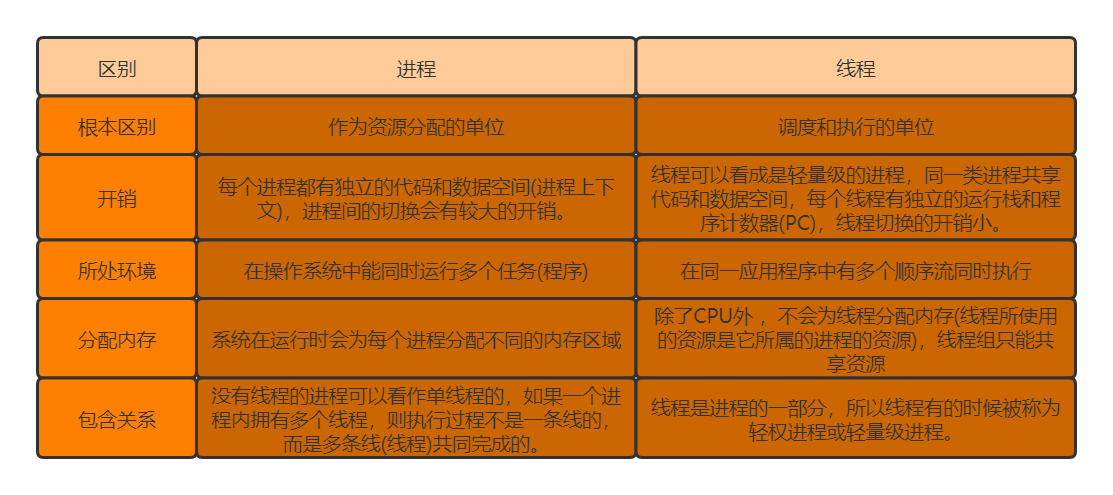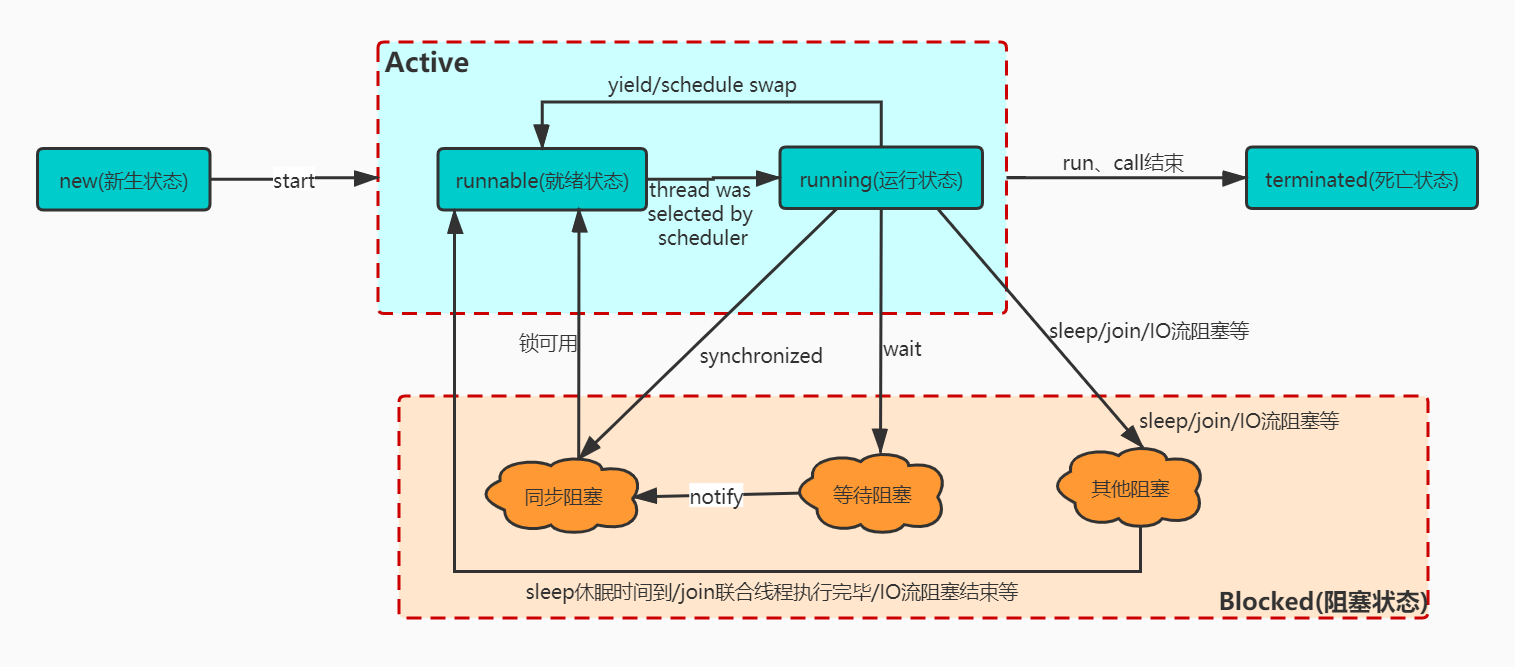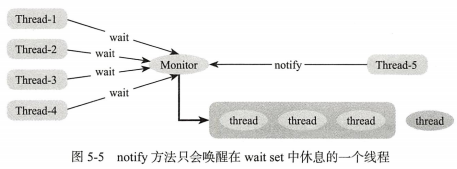背景:
进程和线程的区别:

进程的内存大小为:堆内存+线程数量*栈内存,即线程数量 =( 最大地址空间[MaxProcessMemory] - JVM堆内存 - 系统保留内存[ReservedOsMemory] )/ ThreadStackSize(XSS),从中可以看出,线程的数量随栈内存的增多而减少。
线程是程序执行的一个路径,每一个线程都有自己的局部变量表、程序计数器(指向正在执行的指令指针)以及各自的生命周期。当启动了一个Java虚拟机(JVM)时,从操作系统开始就会创建一个新的进程(JVM进程),JVM进程将会派生或者创建很多线程。
- 一个线程的创建肯定是由另一个线程完成的;
- 被创建线程的父线程是创建它的线程;
线程会带来额外的开销,如CPU调度时间、并发控制开销等;每个线程在自己的工作内存交互,加载和存储主内存控制不当会造成数据不一致。
一.线程创建方式:
-
构造Thread类:实现线程的执行单元run有两种方式,分别是下面
-
继承Thread,重写run方法:Thread实现了Runnable接口,使用start开启线程,start开启后线程会加入调度器,然后调用run方法,start会调用start0本地方法跟OS进行交互运行;下面是start源码解析
复制代码1
2
3
4
5
6
7
8
9
10
11
12
13
14
15
16
17
18
19
20
21
22
23
24
25
26
27
28
29
30
31
32
33
34
35
36
37
38
39
40
41
42
43
44
45
46
47
48
49
50/** * Causes this thread to begin execution; the Java Virtual Machine * calls the <code>run</code> method of this thread. * 开启线程,JVM会调用run方法【start使用了模板方法】 * <p> * It is never legal to start a thread more than once. * 不能两次启动线程,否则报IllegalThreadStateException异常 * In particular, a thread may not be restarted once it has completed * execution. * 一个线程生命周期结束,也就是到了TERMINATED状态,再次调用start方法是不允许的, * 也就是TERMINATED状态没法回到RUNNABLE/RUNNING状态。 * * @exception IllegalThreadStateException if the thread was already * started. * @see #run() * @see #stop() */ public synchronized void start() {//线程安全的 /** * This method is not invoked for the main method thread or "system" * group threads created/set up by the VM. Any new functionality added * to this method in the future may have to also be added to the VM. * 这个方法不会被主线程调用或通过虚拟机系统线程组创建起来。未来任何添加到该方法里的新功能可能需要加入到虚拟机中 * * A zero status value corresponds to state "NEW".
* 线程被构造后的new状态,threadStatus的属性值是0 */ if (threadStatus != 0) throw new IllegalThreadStateException(); /* Notify the group that this thread is about to be started * so that it can be added to the group's list of threads * and the group's unstarted count can be decremented.
* 通知线程组新线程将要启动,以便它可以添加到线程组列表并且线程组没有开始计数*/ group.add(this);//加入线程组 boolean started = false; try { start0();//调用本地方法 started = true; } finally { try { if (!started) {//启动失败 group.threadStartFailed(this);//线程启动失败,从组中移除该线程 } } catch (Throwable ignore) { /* do nothing. If start0 threw a Throwable then it will be passed up the call stack */ } } }复制代码1void add(Thread t) {
synchronized (this) {
if (destroyed) {//线程组状态校验
throw new IllegalThreadStateException();
}
if (threads == null) {
threads = new Thread[4];//初始化长度为4的线程组
} else if (nthreads == threads.length) {
threads = Arrays.copyOf(threads, nthreads * 2);//数组满了就扩容2倍
}
threads[nthreads] = t;//当前线程添加到线程组中
// This is done last so it doesn't matter in case the
// thread is killed
nthreads++;//线程数+1
// The thread is now a fully fledged member of the group, even
// though it may, or may not, have been started yet. It will prevent
// the group from being destroyed so the unstarted Threads count is
// decremented.
nUnstartedThreads--;//未启动线程数-1
}
}复制代码1private native void start0();//本地方法调用重写的run方法复制代码1void threadStartFailed(Thread t) {
synchronized(this) {
remove(t);//移除当前线程
nUnstartedThreads++;//没有启动的线程数量+1
}
}
//=======================测试============================复制代码1
2
3
4
5
6
7
8
9
10
11
12
13
14
15
16
17
18
19
20
21
22
23
24
25Thread t = new Thread(){ @Override public void run(){ try { TimeUnit.SECONDS.sleep(10); } catch (InterruptedException e) { e.printStackTrace(); } } }; t.start(); t.start();//不能两次启动,第二次启动是不允许的,报IllegalThreadStateException,此时该线程是处于运行状态
//=======================测试============================== Thread t = new Thread(){ @Override public void run(){ try { TimeUnit.SECONDS.sleep(10); } catch (InterruptedException e) { e.printStackTrace(); } } }; t.start(); TimeUnit.SECONDS.sleep(10);//设置休眠时间,上面的线程的生命周期已经终止,下面再次启动报IllegalThreadStateException t.start();
-
-
-
实现Runnable接口,重写run方法并且将Runnable实例用作构造Thread的参数【单继承有局限性,推荐使用接口】:将线程的控制(start)和业务逻辑(run)的运行彻底分离开来,使用的是策略模式;Thread的run方法是不能共享的,但Runnbale的run方法可以共享,使用同一个Runnable的实例构造不同的Thread实例;把实现类对象(实现Runnable接口的类的实例化)放入代理类对象(Thread构造方法)中,使用的是代理模式;下面是静态代理的代码解释:
复制代码1
2
3
4
5
6
7
8
9
10
11
12
13
14
15
16
17
18
19
20
21
22
23
24
25
26
27
28
29
30
31public class StaticProxy { public static void main(String[] args) { new Weeding(new Me()).happyMarry(); // new Thread(对象).start();类似 } } interface Marry { void happyMarry(); } //真实角色 class Me implements Marry { @Override public void happyMarry() { System.out.println("me will marry!"); } } //代理对象 class Weeding implements Marry{ //真实角色 private Marry marry; public Weeding(Marry marry){ this.marry=marry; } @Override public void happyMarry() { System.out.println("start"); marry.happyMarry(); System.out.println("end"); } }
-
-
实现Callable接口,重写call方法,Future获取返回值:Callable能接受一个泛型,然后在call方法中返回一个指定类型的值;
复制代码1
2
3public interface Callable<V> { V call() throws Exception; }复制代码1
2
3
4
5
6
7
8
9
10
11
12
13
14
15
16
17
18
19
20
21
22
23
24
25
26
27
28
29
30
31
32
33
34
35//线程池队列开启线程,不会产生脏读数据 //使用步骤: //1.创建目标对象new //2.创建执行服务线程池 //3.提交执行submit //4.获取结构get //5.关闭服务shutdownNow public class MyThread implements Callable { private static int count = 20; public static void main(String[] args) throws ExecutionException, InterruptedException { MyThread m1 = new MyThread(); MyThread m2 = new MyThread(); MyThread m3 = new MyThread(); MyThread m4 = new MyThread(); ScheduledExecutorService service = new ScheduledThreadPoolExecutor(2, new BasicThreadFactory.Builder().namingPattern("schedule-pool-%d").daemon(true).build()); Future submit = service.submit(m1); Future submit1 = service.submit(m2); Future submit2 = service.submit(m3); Future submit3 = service.submit(m4); System.out.println(submit.get()); System.out.println(submit1.get()); System.out.println(submit2.get()); System.out.println(submit3.get()); service.shutdown(); } @Override public Object call() throws Exception { count--; return count; } }
-
匿名内部类;
复制代码1
2
3
4
5
6
7
8
9
10
11
12
13new Thread(){//相当于继承Thread的方式 public void run(){ System.out.println("thread1 start ... "); } }.start(); new Thread(new Runnable() {//相当于实现Runnable接口的方式 @Override public void run() { System.out.println("thread2 start .... "); } }).start(); -
定时器(Timer);
复制代码1
2
3
4
5
6
7Timer timer = new Timer();//创建时间器 timer.schedule(new TimerTask() {//使用schedule,参数为定时器任务并重写run方法 @Override public void run() { System.out.println("timer task is run"); } }, 0, 1000); -
线程池(内部使用队列,所以加入线程池的线程是顺序执行):使用execute和重写Runnbale的run方法;
复制代码1
2
3
4
5
6
7
8ScheduledExecutorService service = new ScheduledThreadPoolExecutor(2, new BasicThreadFactory.Builder().namingPattern("schedule-pool-%d").daemon(true).build()); service.execute(new Runnable() { @Override public void run() { System.out.println("run test"); } }); -
lambda表达式;
复制代码1
2
3
4
5
6new Thread(()-> { for(int i = 1 ; i<10 ; i++){ System.out.println("It is a lambda function!"); } }).start(); -
Spring方式(@Async注解);
复制代码1
2
3
4
5
6
7
8@Test public void test() { run(); } @Async public void run(){ System.out.println("Async Test"); }
二.线程生命周期
-
new新生状态:当用new创建一个Thread对象时,此时它并不处于执行状态,因为没有调用star启动该线程,那么线程的状态为new状态,也就是说,它只是Thread对象的状态,在没有start之前,该线程是不存在的;
-
runnable就绪状态:线程对象进入runnable就绪状态必须调用start方法,那么此时才是真正地在JVM进程中创建了一个线程;就绪状态不会直接进入阻塞状态和死亡状态,即使是在线程的执行逻辑中调用wait、sleep或其他block的IO操作等,也必须先获得CPU的调度执行权才可以,严格来说,就绪状态的线程只能意外终止或进入运行状态;
-
running运行状态:一旦CPU通过轮询或其他方式从任务可执行队列中选中了线程,此时它才能真正地执行自己的逻辑代码;一个正在running状态的线程事实上也是一个runnable的,但是反过来则不成立;

-
sleep:使当前线程进入指定毫秒级的休眠,暂停执行,但不会放弃monitor锁的所有权,即不会释放锁资源;使用TimeUnit来替代Thread.sleep,省去了时间单位的换算步骤;
-
yield:属于一种启发式的方法,其会提醒调度器我愿意放弃当前的CPU资源,如果CPU的资源不紧张,则会忽略这种提醒;yield只是一个提示(hint),CPU调度器并不会担保每次都能满足yield提示;
-
sleep和yield的区别:
-
sleep会导致当前线程暂停指定的时间,没有CPU时间片的消耗;
-
yield只是对CPU调度器的一个提示,如果CPU调度器没有忽略这个提示,它会导致线程上下文的切换;
-
sleep会使线程短暂block,会在给定的时间内释放CPU资源;
-
yield会使running状态的线程进入runnable状态(如果CPU调度器没有忽略这个提示的话);
-
sleep几乎百分之百地完成了给定时间的休眠,但yield的提示并不能一定担保;
-
一个线程sleep另一个线程interrupt会捕获到中断信号,而yield则不会;
-
-
join:join某个线程A,会使当前线程B进入等待,直到线程A结束生命周期;可以使用join来达到线程顺序执行的效果;
-
wait:表示线程一直等待,直到其他线程通知,与sleep不同的是它会释放锁;调用wait会加入wait set中,notify会随机唤醒一个,notifyAll会弹出所有线程;

-
notify:唤醒一个处于等待状态的线程;
-
notifyAll:唤醒同一个对象上所有调用wait方法的线程,优先级高的线程优先调度;
-
synchronized:同步,内置锁、互斥锁、可重入锁,锁定共享资源(共享资源对象不能为null,使用static修饰保持对象引用地址只有一份),依赖JVM,JVM指令是monitor enter和monitor exit;synchronized的指令严格遵守java happens-before规则,一个monitor exit指令之前必定要有一个monitor enter;不可中断锁,适合竞争不激烈,可读性好;
-
锁信息存在对象头中:
-
Mark Word
-
线程id
-
Epoch
-
对象的分代年龄信息
-
是否是偏向锁
-
锁标志位
-
-
Class Metadata Address
-
- 使用范围:
- 修饰代码块:大括号括起来的代码,作用于调用的对象;
复制代码1
2
3
4
5
6
7
8
9
10
11
12
13
14
15
16
17
18
19
20
21
22@Override public void run() { synchronized (this) {//类A实现了Runnable,重写了run方法,实例化对象a,b分别加入到Thread构造方法中并开启线程,this是两个不同的对象; System.out.println(this.hashCode()); } } MyThread thread = new MyThread(); MyThread thread2 = new MyThread(); Thread t1 = new Thread(thread, "t1"); Thread t2 = new Thread(thread2, "t2"); Thread t3 = new Thread(thread, "t3"); Thread t4 = new Thread(thread, "t4"); t1.start(); t2.start(); t3.start(); t4.start(); ===========结果================= 693024158 1259146238 1259146238 1259146238 - 修饰方法:整个方法,作用于调用的对象;
复制代码1
2
3
4
5
6
7
8
9
10
11
12
13
14
15
16
17
18
19
20@Override public synchronized void run() {//类A实现了Runnable,重写了run方法,实例化对象a,b分别加入到Thread构造方法中并开启线程,this是两个不同的对象; System.out.println(this.hashCode()); } MyThread thread = new MyThread(); MyThread thread2 = new MyThread(); Thread t1 = new Thread(thread, "t1"); Thread t2 = new Thread(thread2, "t2"); Thread t3 = new Thread(thread, "t3"); Thread t4 = new Thread(thread, "t4"); t1.start(); t2.start(); t3.start(); t4.start(); ===============结果=================== 487590100 697138600 697138600 697138600 - 修饰静态方法:整个静态方法,作用于所有对象;
复制代码1
2
3
4
5
6
7
8
9
10
11
12
13
14
15
16
17
18
19
20
21
22
23@Override public void run() { test1(); } public static synchronized void test1(){ System.out.println(MyThread.class.hashCode()); } MyThread thread = new MyThread(); MyThread thread2 = new MyThread(); Thread t1 = new Thread(thread, "t1"); Thread t2 = new Thread(thread2, "t2"); Thread t3 = new Thread(thread, "t3"); Thread t4 = new Thread(thread, "t4"); t1.start(); t2.start(); t3.start(); t4.start(); ===============结果=================== 6566818 6566818 6566818 6566818 - 修饰类:括号括起来的部分,作用于所有对象;
复制代码1
2
3
4
5
6
7
8
9
10
11
12
13
14
15
16
17
18
19
20
21
22
23
24
25@Override public void run() { test1(); } public static void test1(){ synchronized (MyThread.class) { System.out.println(MyThread.class.hashCode()); } } MyThread thread = new MyThread(); MyThread thread2 = new MyThread(); Thread t1 = new Thread(thread, "t1"); Thread t2 = new Thread(thread2, "t2"); Thread t3 = new Thread(thread, "t3"); Thread t4 = new Thread(thread, "t4"); t1.start(); t2.start(); t3.start(); t4.start(); ==========结果============= 6566818 6566818 6566818 6566818
- 修饰代码块:大括号括起来的代码,作用于调用的对象;
-
- Lock:显示锁,依赖特殊的CPU指令;可中断锁,多样化同步,竞争激烈时能维持常态;
复制代码1
2
3
4
5
6
7
8
9
10
11
12
13
14
15
16
17
18
19
20
21public class MyLock implements Lock {//自定义Lock private boolean isLocked = false; @Override public void lock() { while (isLocked){//已经获得锁 try { wait();//等待 } catch (InterruptedException e) { e.printStackTrace(); } } isLocked=true;//获锁成功 } @Override public void unlock() { isLocked = false;//释放锁 notify();//唤醒等待线程 } }
最后
以上就是孝顺老虎最近收集整理的关于多线程高并发编程(1) -- 基础及详解的全部内容,更多相关多线程高并发编程(1)内容请搜索靠谱客的其他文章。








发表评论 取消回复